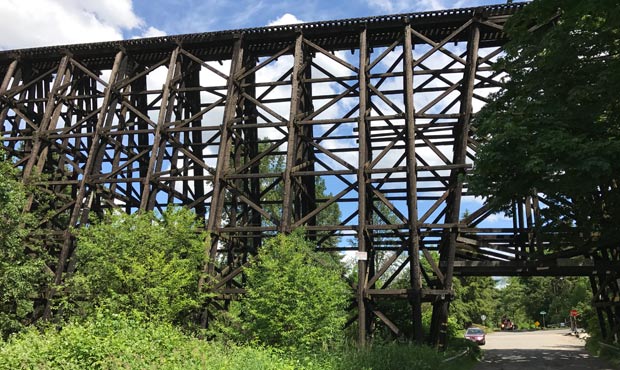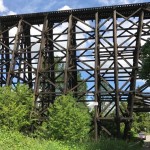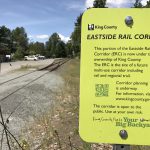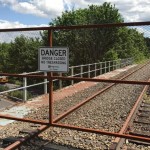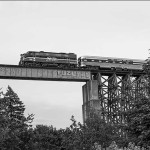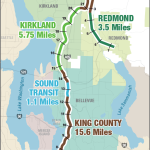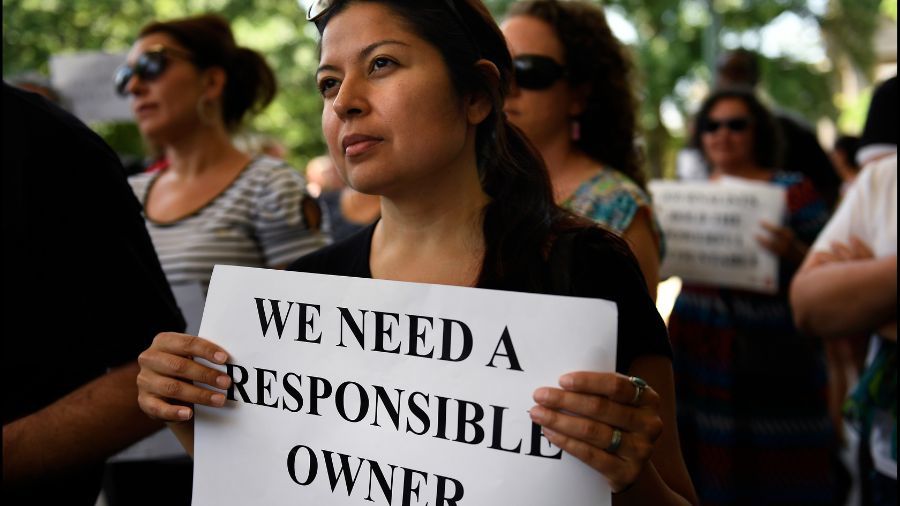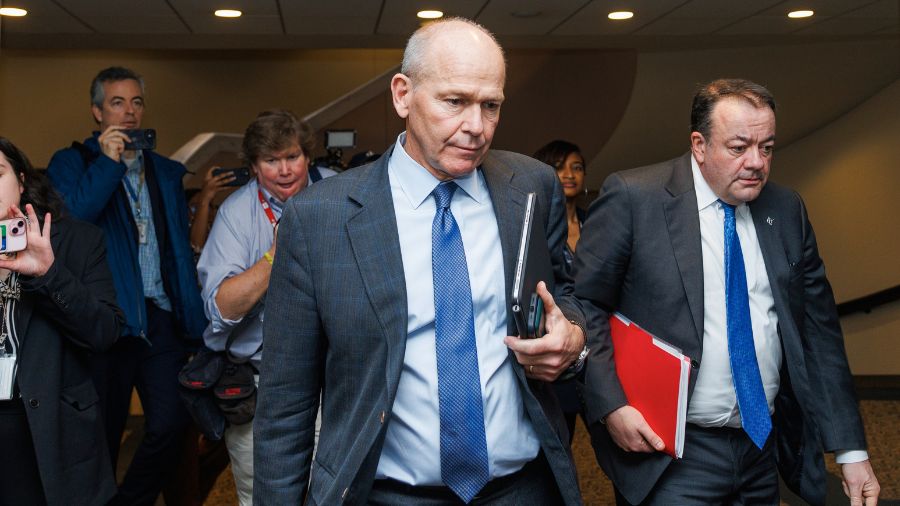Iconic trestle is a bridge to Eastside trail’s future
Jun 7, 2017, 10:26 AM | Updated: Jun 8, 2017, 8:24 am
When Jack Christensen of Edmonds made his first trip across the Wilburton Trestle, the view to the west of what’s now downtown Bellevue was a little different than it is today.
“Well, there wasn’t as much there,” Christensen said. “There were a couple of farmhouses, maybe, or small buildings, but Bellevue as we know it now just simply didn’t exist. It was open farmland.”
Christensen, 90, made that first trip across the 100-foot tall, roughly 1,000-foot long trestle back in 1944. That was when he first went to work for the Northern Pacific Railroad.
“There was a trainman’s walk on one side, but the other side you’re just like suspended in air, you know,” Christensen said. “[But] the Wilburton Trestle was pretty solid. And I don’t recall any apprehension crossing it. It was just part of the trip.”
The wooden trestle was built to cross Mercer Slough in the days before the Ballard Locks, which dropped the level of Lake Washington and nearly dried up Mercer Slough. The trestle also served as a link in the regional rail system for more than a century, and it’s now set to once again play an important role in the future of transportation and recreation.
Local investors first envisioned a rail line on the east side of Lake Washington around 1890, and the group officially incorporated as the Lake Washington Belt Line Company in 1891 and began buying real estate. The Panic of 1893 and other economic troubles may have led to the project being delayed, and the Northern Pacific eventually acquired the land. It wasn’t until September 1905 that trains between Seattle and Sedro-Woolley in Skagit County began running on the route.
When it originally opened, The Seattle Times said the line had been built to bypass the busy rail yards in Seattle.
“The belt line was constructed for the purpose of handling through freight to and from points north of Seattle and obviating the necessity for bringing these trains into the congested yards of this city,” a Times reporter wrote on Sept. 13, 1905.
The Lake Washington Belt Line went from Black River Junction in Renton to Woodinville over roughly 24 miles of rail. During its heyday in the early to mid-20th century, freight trains ran from Northern Pacific’s big yard in Auburn, up the Lake Washington Belt Line to Woodinville, and then continued north to a yard at Sumas in Whatcom County on the Canadian border.
“The Belt Line was pretty handy,” said Jack Christensen. “We had freight trains out of Auburn, we had one to Sumas, and in the 1950s we put the second one on to Bellingham. So we had two trains a day.”
Christensen says that in the 1950s, the northbound trains were generally empty boxcars, but the southbound trains brought lumber and coal from Canada. He also says that “through traffic” on the Belt Line — freight using the route to bypass Seattle — had decreased in the late 1970s and early 1980s, but that local industrial customers along the tracks continued to take advantage of the rail service.
It was in February 2008 that the last freight train crossed the trestle, delivering parts to the Boeing plant in Renton. From 1992 to 2007, the Spirit of Washington Dinner Train used the trestle as it ran back and forth between the depot in Renton and the Columbia Winery in Woodinville.
The death knell for the Belt Line — and for freight trains and the Spirit of Washington along the route — was the widening of Interstate 405 through Bellevue a decade ago. Just north of Interstate 90, the freeway lanes crossed under the tracks through the Wilburton Tunnel, which was built in 1972. It was demolished in August 2008, and the 103-year history of the Belt Line was sliced in half.
A year later, through the first of a complex set of real estate transactions, BNSF Railway sold the Belt Line to the Port of Seattle, including tracks between Woodinville and Snohomish that are still in use by trains. Then, a handful of other public agencies bought pieces of the route from the Port for a variety of purposes.
Collectively, the old Belt Line right-of-way is now known as the Eastside Rail Corridor, and plans and construction along the route are in various stages of development for bike and pedestrian trails, in some places shared with utilities and, in a few places, light rail.
The City of Kirkland owns the nearly six-mile stretch within its borders and has already removed the old rails and converted the route into an “interim trail” known as the Cross-Kirkland Corridor.
Kirkland’s project was temporarily halted by a lawsuit in 2013. The suit was filed by rail advocates who wanted to preserve the heavy rail tracks in the corridor, but the City of Kirkland prevailed and the tracks were removed.
The City of Redmond owns a four-mile long “spur” from the Belt Line that runs from Woodinville to downtown Redmond. It’s called the Redmond Central Connector, and the paved trail is set to open next month.
Sound Transit owns a one-mile stretch in downtown Bellevue (north of the Wilburton Trestle) that will be used by the East Link light rail line that opens in 2023. Geoff Patrick of Sound Transit says that ST3, which was approved last November, includes funding for a light rail route from South Kirkland to Issaquah that will be completed in 2041 and that will likely use part of the corridor. ST3 also funds a study (though not construction) of a route from Bothell to Bellevue which would also likely use the corridor.
King County owns the largest portion of the Eastside Rail Corridor — about 16 miles of the route, including five miles that will open to interim use later this year. This includes a one-mile stretch connecting the Cross-Kirkland Corridor to the new 520 Trail, and a four-mile stretch from Gene Coulon Park in Renton to Kennydale Park in Bellevue.
“While we get those in place, we’re also moving forward to design a significant section of the trail in Bellevue that includes the Wilburton Trestle,” said Erica Jacobs, a project manager with King County Parks.
Jacobs says the Wilburton Trestle, which is currently fenced off, will open to public access in 2020, and a new bridge for pedestrians and bikes will be built across I-405 where the Wilburton Tunnel once stood. Incidentally, both the tunnel and the trestle are named for the community of Wilburton, an early 20th-century logging settlement founded nearby by Manley Wilbur of the Wilbur Lumber Company.
“We’re working on the toughest pieces on the most central part of the corridor and taking advantage of opportunities that are arising to coincide with other transportation projects such as Sound Transit’s East Link light rail and WSDOT’s work on 405 … to get some of the key pieces of trail in place sooner rather than later,” Jacobs said.
Jacobs says that the Wilburton Trestle came up often during public meetings and that it will be one of the major highlights of the new trail – though it will never carry trains or light rail, as some transportation advocates had wanted.
“It will have glorious views of the downtown Bellevue skyline and the surrounding area,” Jacobs said. “We hope to design in little viewpoints, ‘eddies’ … that you can step out into – a little view area, if you will – to get out of the way of the trail [traffic] and still have a place to stop and enjoy that.”
Jacobs is also excited about the connections to other pieces of King County 175-mile of regional trail network – Burke-Gilman Trail, Sammamish River Trail, Snoqualmie Valley Trail — that Eastside Rail Corridor will make possible.
“[The Eastside Rail Corridor] becomes something that pulls together a network of trails that provide recreation opportunities as well as non-motorized transportation for the Eastside,” Jacobs said.
Jacobs adds that there have been concerns expressed by some property owners along the route of the trail, mainly about impacts to parking and privacy, but she says that King County is addressing those specific concerns.
“That said, there is widespread support and the communities all along the trail are really embracing the trail, and looking forward to it being an amenity to their community as well,” Jacobs said.
As for that name – “Eastside Rail Corridor” – which sounds a little bit on the clinical side, Jacobs says not to worry, that it’s just a placeholder.
“What we’re working on as a region is moving toward a collective renaming of it, so it has a name for the trail that resonates, but that also captures the vision that we all originally had for the corridor as one that contains trail, transit, and utilities and is a multiple-use vision for that corridor serving the Eastside,” Jacobs said.
Fine. Have your collective effort to capture the vision and make everyone resonate. Or, save time and effort and take this suggestion, free of charge: honor the origin and history of the route by calling it the “Lake Washington Belt Line Trail” or “BLT” for short.

